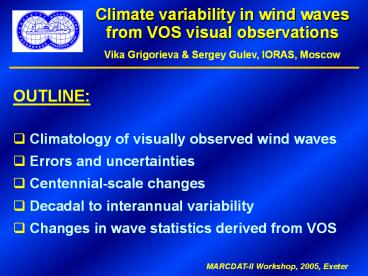Climate variability in wind waves - PowerPoint PPT Presentation
Title:
Climate variability in wind waves
Description:
Homogenization: sub-sampling. for 7,15,25,50. reports per. region per. month. Homogenized time series. Buoys: Gower 2002: Bacon and Carter 1991. Gulev and Hasse 1999 ... – PowerPoint PPT presentation
Number of Views:22
Avg rating:3.0/5.0
Title: Climate variability in wind waves
1
Climate variability in wind waves from VOS visual
observations
Vika Grigorieva Sergey Gulev, IORAS, Moscow
OUTLINE
- Climatology of visually observed wind waves
- Errors and uncertainties
- Centennial-scale changes
- Decadal to interannual variability
- Changes in wave statistics derived from VOS
MARCDAT-II Workshop, 2005, Exeter
2
Visual VOS observations 2 streams (1784-1948)
and (1948-2003)
3
- Global climatology of wind waves from VOS data
- http//www.sail.msk.ru/atlas
- monthly
- 1958-2002 (updated)
- 2-degree resolution
- Separate estimates of
- sea, swell, SWH
- Gulev and Grigorieva
- JGR, 2003
4
All fields are accompanied by
Random observational errors
Sampling errors
See poster of Grigorieva and Gulev for the error
analysis
5
Very long-term changes along the major ship
routes
65 regions with high sampling during 1885-2002
Homogenization sub-sampling for 7,15,25,50
reports per region per month
6
Homogenized time series
Buoys Gower 2002
7
Very long-term changes linear
trends Gulev and Grigorieva 2004
8
Trends in sea, swell and SWH 1958-2002
sea
sea
swell
swell
SWH
SWH
9
Winter (JFM) 1st EOFs of sea, swell and SWH
sea
sea
swell
swell
SWH
SWH
10
Principal components
Atlantic R(HWNAO)0.68 R(HSNAO)0.48 R(SWHNAO)
0.81
Pacific R(HWNPI)0.72 R(HSNPI)0.58 R(SWHNPI)
0.61
11
Canonical patterns
scalar wind
Number of cyclones
sea
swell
SWH
SWH
12
Extreme waves from VOS problem of estimation
IDM initial distribution method
methodologically, most relevant for VOS, but
does not allow for reliable estimation of
extreme waves POT peak over threshold
sensitive to sampling inhomogeneity
100-yr returns in SWH - IDM
13
Estimation of extreme wave heights - POT
14
Changes in extreme SWH 100-yr returns
1980 - 1970
1990 - 1980
IDM
? 2 m
? - 1 m
? - 1 m
? 2 m
? 2 m
? - 2 m
POT
15
Conclusions
Visual wave data allow for the analysis of
centennial-scale variability of ocean wind wave
characteristics linear trends in the North
Pacific may amount to 1.2 m per century, being
much smaller in the North Atlantic.
Interannual variability patterns are different
for sea and swell, implying forcing frequency
(e.g. cyclones) as a driving mechanism of swell
changes with wind speed being responsible for the
variations in sea.
Extreme wave statistics can be evaluated from VOS
using IDM and POT methods. POT method shows the
higher extreme waves, which are more close to
those obtained from the model hindcasts.
However, estimation of decadal changes in extreme
waves shows less skills of the POT method,
largely influenced by sampling inhomogeneity
16
Sea, swell, SWH 100-years return































